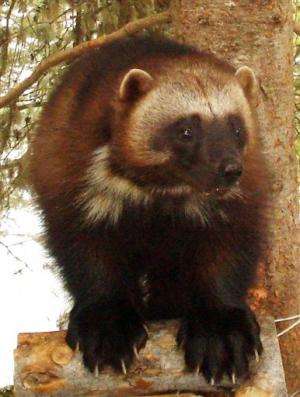US: Warming imperils wolverines (Update)

The tenacious wolverine, a snow-loving carnivore sometimes called the "mountain devil," is being added to the list of species threatened by climate change—a dubious distinction that puts it in the ranks of the polar bear and several other animals that could see their habitats shrink drastically due to warming temperatures.
Federal wildlife officials Friday proposed Endangered Species Act protections for the wolverine in the Lower 48 states. That's a step twice denied under the Bush administration, then delayed in 2010 when the Obama administration said other imperiled species had priority.It's likely to mean an end to trapping the animals for their fur.
But U.S. said they won't use the animal's status as a means to regulate the greenhouse gases blamed in climate change. And other human activities—from snowmobiling and skiing to infrastructure development and transportation corridors—would not be curtailed because they do not appear to be significant threats to wolverines, officials said.
There are an estimated 250 to 300 wolverines in the contiguous U.S., clustered in small, isolated groups primarily in the Northern Rockies of Montana, Idaho, Wyoming and Washington. Larger populations persist in Alaska and Canada.
Maxing out at 40 pounds (18 kilograms) and tough enough to stand up to grizzly bears, the animals will be no match for anticipated declines in deep mountain snows female wolverines need to establish dens and raise their young, scientists said.
In some areas suitable habitat could disappear entirely, officials said.
Yet because those losses could take decades to unfold, federal wildlife officials said there's still time to bolster the population, including by reintroducing them to the high mountains of Colorado.
"This is a species there is still time to do something about," said Mike Thabault, ecological services director for the U.S. Fish and Wildlife Service's mountain-prairie region.
Wildlife advocates, who sued to force the government to act on the issue, said the animal's plight should be used by the Obama administration to leverage tighter restrictions on greenhouse gas emissions.
As with the polar bear, the government is seeking to sidestep that thorny proposition by not addressing threats outside the wolverine's immediate range. Thabault said the agency would be on tenuous scientific grounds if it tried to draw a link between specific emission sources and impacts on wolverines.
Advocates expressed disappointment, with Noah Greenwald from the Center for Biological Diversity saying the administration "should not be exempting greenhouse gas emissions from the Endangered Species Act."
John Martin, a Washington, D.C. attorney for the energy industry during litigation over polar bears, said he doesn't expect any change in the administration's policy against using endangered wildlife to regulate emissions.
Friday's proposal would allow Colorado's wildlife agency to reintroduce an experimental population of wolverines that eventually could spill into neighboring portions of New Mexico and Wyoming.
But the proposal would shut down wolverine trapping in Montana, the only one of the Lower 48 states where the practice is still allowed.
Once found throughout the Rocky Mountains and in California's Sierra Nevada mountain range, wolverines were wiped out across most of the U.S. by the 1930s due to unregulated trapping and poisoning campaigns, said Bob Inman, a wolverine researcher with the Wildlife Conservation Society.
In the decades since, they have largely recovered in the Northern Rockies but not in other parts of their historical range.
While reintroducing the animals further south might seem counterintuitive, Inman said Colorado's abundance of 14,000-foot (4,300-meter) mountains make it ideally suited as a refuge for the animals as warmer temperatures set in at lower elevations.
Only one wolverine currently inhabits the state, a male that wandered down several years ago from northern Wyoming. Inman said the state has enough high-mountain territory to support up to 100 more.
"That's like a 30 percent increase in their population size," he added.
Any reintroduction into Colorado would require approval from state wildlife commissioners and the Legislature, Colorado Parks and Wildlife spokesman Randy Hampton said.
Representatives of the state's ski and agriculture industries have previously raised concerns about the potential impacts of wolverines being brought back. Hampton said no decision has been made and it could take years to work out all the details.
Copyright 2013 The Associated Press. All rights reserved. This material may not be published, broadcast, rewritten or redistributed.


















